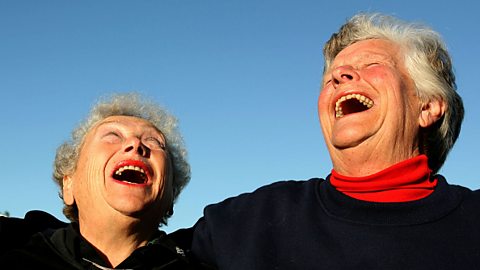They say a smile is worth a thousand words.
Today smiling is often recognised as an expression of happiness, amusement and pleasure, but has that always been the case? ±«Óătv Bitesize takes a look at how the smile has changed over the centuries.

What are the origins of the smile?
The smile has a whopping 30 million year evolutionary history. While it may seem like a friendly gesture, evidence from animal behaviour scientists worldwide have suggested it was originally rooted in fright. One of the earliest studies into the smile has linked it with the idea of âfear grinningâ, or 'silent bared teeth displayâ.
According to the 1990s studies by the A primatologist is a person who studies primates, such as apes and monkeys. Dr Signe Preuschoft, fear grinning can be traced back to primates, such as rhesus monkeys, who used smiling in order to establish dominance or submission, especially in dangerous situations. This monkey business was the origin of our modern smiling habits!
Turn that frown upside down!
Fast forward to 6th Century BC, when Ancient Greece was embracing naturalistic representations of humans in art. This marked the dawn of an era known as the Archaic period. If you take a look at the Greek statues from this age, you may notice the slightly upturned mouths of each figure. This became known as the Archaic smile, which was popular in sculptures created between 650 â 480 BC.
Whilst the true significance of the smile for those at the time is unknown, it has attracted much debate. While some think this might have happened from a growing interest in human anatomy, others believe it may have reflected the ideal state of health and well-being.
Why didnât people smile in paintings?
You may have noticed the lack of smiling in some of historyâs most famous paintings. Take Leonardo da Vinciâs Mona Lisa, whose famous smile has been debated across the world, or Jan van Eyckâs Portrait of a Man, whose tightly pursed mouth is far from beaming.
There are several reasons why people didnât tend to smile in portraits. Most practical of these reasons was that it was hard for both artists to paint and for muses to pose for extended periods of time. To top it off, across Europe people who smiled broadly were regarded highly improper, and therefore it wasnât part of upper-class etiquette â at least not in public.

Say Cheese!
Perceptions of the smile changed forever with the early adoption of photography in the Victorian era. In 1839, the first ever selfie was taken by an amateur chemist called Robert Cornelius at the back of his familyâs store in Philadelphia â 174 years before the word âselfieâ was added to the dictionary!
The launch of Kodakâs original camera in 1888 made photography more accessible to the average person than ever before. Advertising played a big role in the relationship between smiling and photography. In an 1998 essay, the academic Fred Schroeder argues that over the second decade of the 20th Century many advertisers were already using the smile, the most widely recognised symbol for human happiness, to convey the idea of pleasure with their products.
A later 2015 research study between the University of California Berkeley and Brown University investigated high school yearbook photos taken from 1905 to 2005. By analysing a dataset of 37,921 front-facing images, they were able to show that the average lip curvature increased with each decade, with women smiling more than men throughout.
Digital smiles
With the emergence of the internet, it seemed only natural for smiling to surface in the digital world. In 1982, professor Scott Fahlman decided there needed to be a way to decipher humorous posts on the online bulletin board at Carnegie Mellon University. As a result, he suggested that his colleagues use the smiling character sequence :-) to indicate sarcasm or :-( to show seriousness.
Little did he know he was changing how we communicate online forever, with an estimated 10 billion emojis sent each day. According to Unicode Consortium, the organisation responsible for digitising the worldâs languages, the top ten emojiâs internationally of 2021 consisted of 5 smileys. Now thatâs a lot to smile about!
This article was published in June 2022
What happens when we laugh?
The incredibly complicated process of having a good giggle.

Eight things you use every day but never knew their name
What's the proper name for your little toe? Or that bit on the end of your shoelace?

Fabulous scientific facts - as chosen by scientists
The finest undersea teamwork, metallic rain and the fish that could help us reach Mars.
